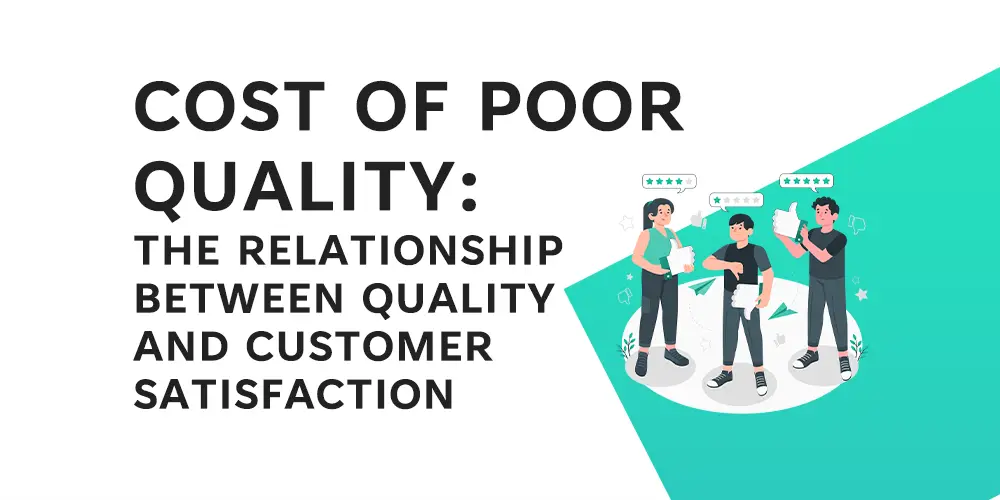The cost of poor quality (COPQ) refers to the total cost of producing and delivering a product or service that does not meet customer expectations. Scrap, rework, warranty claims, product returns, and lost business due to dissatisfied customers can all be included in COPQ. While the direct costs of poor quality can be quantified, the indirect costs of poor quality, such as reputational damage and lost future business, can be much more difficult to quantify.
COPQ’s significance cannot be overstated. When a company fails to deliver a quality product or service, it has an impact not only on the company’s bottom line, but also on customer satisfaction. This is especially true in today’s hyper-competitive business environment, where customers have more options than ever before and are quick to switch to a competitor if they are dissatisfied.
In this blog post, we will look at why COPQ is important and the connection between quality and customer satisfaction. We’ll also look at how to calculate COPQ and strategies for lowering it in order to improve customer satisfaction. Companies that understand the importance of COPQ and focus on quality can not only reduce costs and increase profits but also increase customer satisfaction and loyalty.
What is COPQ?
The cost of poor quality, abbreviated as COPQ, refers to the costs incurred by an organisation as a result of products or services that fail to meet customer requirements or expectations. It includes the costs of internal and external failures, as well as the costs of appraisal and prevention. Internal failure costs are the costs of rework, scrap, and other costs incurred prior to the delivery of the product or service to the customer. External failure costs are those incurred after the product or service has been delivered to the customer, such as warranty claims, returns, and lost business. Appraisal costs are the expenses incurred as a result of quality control measures such as inspections and testing, whereas prevention costs are the expenses incurred as a result of implementing measures to prevent quality problems from occurring in the first place.
Different Types of COPQ (Internal and External)
Internal Failure Costs: These are the expenses incurred as a result of producing defective goods or services. These expenses are incurred prior to the delivery of the product or service to the customer and may include the costs of rework, scrap, and repair. For example, if a product has a flaw, it may need to be reworked or scrapped, incurring additional costs for the company.
External Failure Costs: External failure costs are incurred after the product or service reaches the customer. Warranty claims, returns, lost business, and the cost of resolving customer complaints are examples of these costs. For example, if a product fails to meet the expectations of the customer, the customer may return it, incurring additional costs for the company.

Appraisal Costs: Appraisal costs are the costs associated with quality control measures, such as inspections and testing. These expenses are incurred to ensure that products or services meet customer expectations and are defect-free. A company, for example, may invest in testing equipment to ensure that its products meet quality standards.
Prevention Costs: Prevention costs are the costs of implementing measures to prevent quality problems from occurring in the first place. Training, quality planning, and process improvement initiatives are examples of these costs. A company, for example, may invest in employee training to ensure that employees understand quality requirements and can identify potential quality issues before they occur.
Examples of COPQ
The cost of rework, scrap, and repair, the cost of warranty claims, the cost of product returns, and the cost of resolving customer complaints are all examples of COPQ. For example, if a company manufactures a defective product, it may need to be reworked or scrapped, incurring additional costs. If a customer returns a product, the company may incur additional costs as a result of the return and resolution of the customer complaint. Companies can identify areas for quality improvement and take steps to reduce costs and improve customer satisfaction by measuring COPQ.
What Does COPQ Matter?
Impact on Cost
COPQ is an important metric for calculating the costs of poor quality. When products or services fail to meet customer expectations, the company may incur additional costs such as rework, scrap, warranty claims, and lost business. Companies can identify areas where quality issues are occurring and take steps to reduce costs by measuring COPQ. This can result in significant cost savings for the company as well as increased profitability.
Impact on Profits
Profits can be significantly impacted by COPQ. When products or services fail to meet customer expectations, it can lead to lost business and revenue. Furthermore, the costs of poor quality, such as rework, scrap, and warranty claims, can reduce profitability. Companies can increase customer satisfaction and loyalty by lowering COPQ and improving quality, which can lead to increased revenue and profitability.
Impact on Customer Satisfaction
Customer satisfaction can be significantly influenced by COPQ. When products or services fail to meet the needs or expectations of the customer, it can lead to dissatisfaction and frustration. This can result in negative feedback, complaints, and lost business. Companies can improve quality and ensure that products and services meet customer requirements and expectations by measuring and reducing COPQ. This can result in higher customer satisfaction and loyalty, which can lead to higher revenue and profitability.
The Relationship Between Quality and Customer Satisfaction
How Quality Affects Customer Satisfaction
Quality is critical to customer satisfaction. Customers expect a product or service to meet their needs and expectations when they buy it. If the product or service does not meet these standards, it may cause dissatisfaction and frustration. However, if the product or service meets or exceeds these expectations, it can lead to satisfaction and even loyalty. As a result, quality is a major driver of customer satisfaction.
Evidence Supporting the Link Between Quality and Customer Satisfaction
Numerous studies have found a positive correlation between quality and customer satisfaction. A study conducted by the American Society for Quality, for example, discovered a strong correlation between customer satisfaction and quality. Another study, this time conducted by the University of Michigan, discovered that businesses with higher-quality products and services have higher levels of customer satisfaction.
Furthermore, customer reviews and feedback frequently emphasize the importance of quality in driving customer satisfaction. Customers who are pleased with the quality of a product or service are more likely to leave positive feedback and recommend it to others, resulting in increased sales and revenue.
Examples of Companies with High Customer Satisfaction due to Focus on Quality
There are numerous examples of businesses that have achieved high levels of customer satisfaction as a result of their quality focus. Apple is one such company. Apple is well-known for producing high-quality goods and consistently ranks high in customer satisfaction surveys. Toyota is another example. Toyota places a high value on quality and has implemented numerous quality control measures, which has resulted in high levels of customer satisfaction and loyalty.
Amazon, Zappos, and Costco are other companies with high customer satisfaction due to their focus on quality. These businesses place a premium on quality in their products and services, resulting in high levels of customer satisfaction and loyalty.
Measuring COPQ
How to Measure COPQ
The total cost of poor quality within an organization can be used to calculate COPQ. Internal and external costs associated with poor quality are included, such as the cost of rework, scrap, warranty claims, and lost business. Companies must identify the various types of quality costs and quantify the costs associated with each type in order to measure COPQ.
Tools and Techniques For Measuring COPQ
Companies can measure COPQ using a variety of tools and techniques. These are some examples:
Cost of Quality(COQ) Reports: COQ reports provide an overview of the costs associated with poor quality. These reports categorize the costs, such as prevention costs, appraisal costs, internal failure costs, and external failure costs.
Statistical Process Control (SPC): SPC is a method of monitoring and controlling processes to ensure that they meet quality standards. SPC can be used to identify quality issues and estimate the costs of poor quality.
Failure Mode and Effects Analysis (FMEA): FMEA is a technique for identifying potential flaws in a process or product and estimating the costs associated with each failure mode.
Six Sigma: Six Sigma is a quality management methodology that uses statistical analysis and process improvement techniques to reduce defects and improve quality. Six Sigma can help you identify and quantify the costs of poor quality.
Importance of Accurate Measurement for Effective Decision-making
Accurate COPQ measurement is required for effective decision-making. Companies may not have a complete understanding of the costs associated with poor quality without accurate measurement, which can lead to incorrect decisions. For example, if a company underestimates the cost of poor quality, it may fail to invest in quality control measures, resulting in higher costs and lower customer satisfaction.
Accurate COPQ measurement can also assist businesses in prioritizing their quality improvement efforts. Companies can focus their efforts on the areas that will have the greatest impact on reducing COPQ and improving quality by identifying the areas where quality problems are occurring and quantifying the costs associated with poor quality.
Reducing COPQ for Improved Customer Satisfaction
Strategies for Reducing COPQ
Reducing COPQ necessitates a collaborative effort from the entire organisation. Companies can use the following strategies to reduce COPQ and improve customer satisfaction:
Implementing a quality management system (QMS): A quality management system (QMS) can assist businesses in improving their quality control processes and lowering the occurrence of defects. A quality management system (QMS) provides a structured approach to quality management and can assist businesses in identifying areas for improvement.
Continuous improvement: Continuous improvement involves ongoing efforts to improve processes and eliminate waste. Companies can reduce the occurrence of defects and improve quality by continuously reviewing and improving processes.
Supplier management: Suppliers are essential in quality management. Companies can reduce the occurrence of defects and improve quality by working closely with suppliers and ensuring that they meet quality standards.
Employee involvement and training: Employees are on the front lines of quality management. Companies can improve the quality of their products and services by providing training and involving employees in quality improvement efforts.
Benefits of Reducing COPQ Beyond Customer Satisfaction
Beyond improved customer satisfaction, lowering COPQ has several advantages. These advantages include:
Cost savings: By reducing the incidence of defects and waste, companies can save money on materials, labour, and other costs associated with poor quality.
Improved efficiency: As processes become more streamlined and waste is reduced, improved quality control processes can lead to increased efficiency.
Improved brand reputation: Companies that prioritise quality are often perceived as more trustworthy and reliable, which can lead to increased sales and improve their brand reputation.
Case Studies of Companies that have been successful in reducing COPQ
Many businesses have successfully reduced COPQ and increased customer satisfaction by implementing strategies like the ones listed above. Toyota, for example, has long been known for its dedication to quality. Toyota reduces the occurrence of defects and improves quality through a combination of employee training, continuous improvement, and supplier management. This has contributed to Toyota’s strong reputation for quality and dependability.
GE Aviation, for example, uses Six Sigma and other quality improvement methodologies to reduce COPQ. GE Aviation has managed to reduce defects and improve quality while saving millions of dollars.
Conclusion
Finally, the cost of poor quality (COPQ) has a significant impact on the costs, profits, and, most importantly, customer satisfaction of a company. Companies that prioritise quality management and work actively to reduce COPQ will see significant improvements in overall quality, customer satisfaction, and financial performance.
Accurately measuring COPQ is critical for effective decision-making, and reducing COPQ requires a collaborative effort from the entire organisation. Companies can reduce COPQ and improve quality by implementing strategies such as continuous improvement, employee training, supplier management, and a quality management system.
Reduced COPQ can ultimately result in cost savings, increased efficiency, and a better brand reputation, all of which can lead to increased customer satisfaction and a stronger bottom line. Companies that prioritise quality management and work to reduce COPQ will be better positioned for long-term success in today’s highly competitive business environment.
References
- Prashar, A., 2014. Adoption of Six Sigma DMAIC to reduce cost of poor quality. International Journal of Productivity and Performance Management, 63(1), pp.103-126.
- Mahmood, S., M. Ahmed, S., Panthi, K. and Ishaque Kureshi, N., 2014. Determining the cost of poor quality and its impact on productivity and profitability. Built Environment Project and Asset Management, 4(3), pp.296-311.
- Cosmin, D. and Ana-Maria, S., 2013. Cost of quality and Taguchi loss function. Annals of the University Of Oradea, Economic Science Series, 22(1), pp.1479-1485.
- Ashraf, S.R., 2015. Compare cost of good quality & cost of poor quality and have a wise decision: A study from automobile industry of Pakistan.








